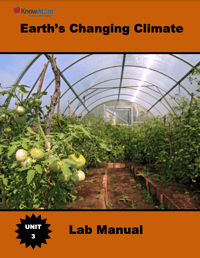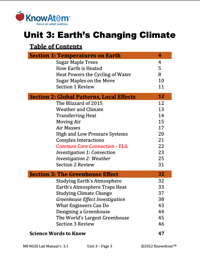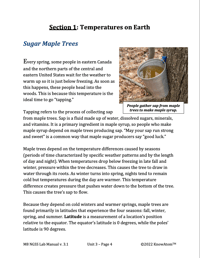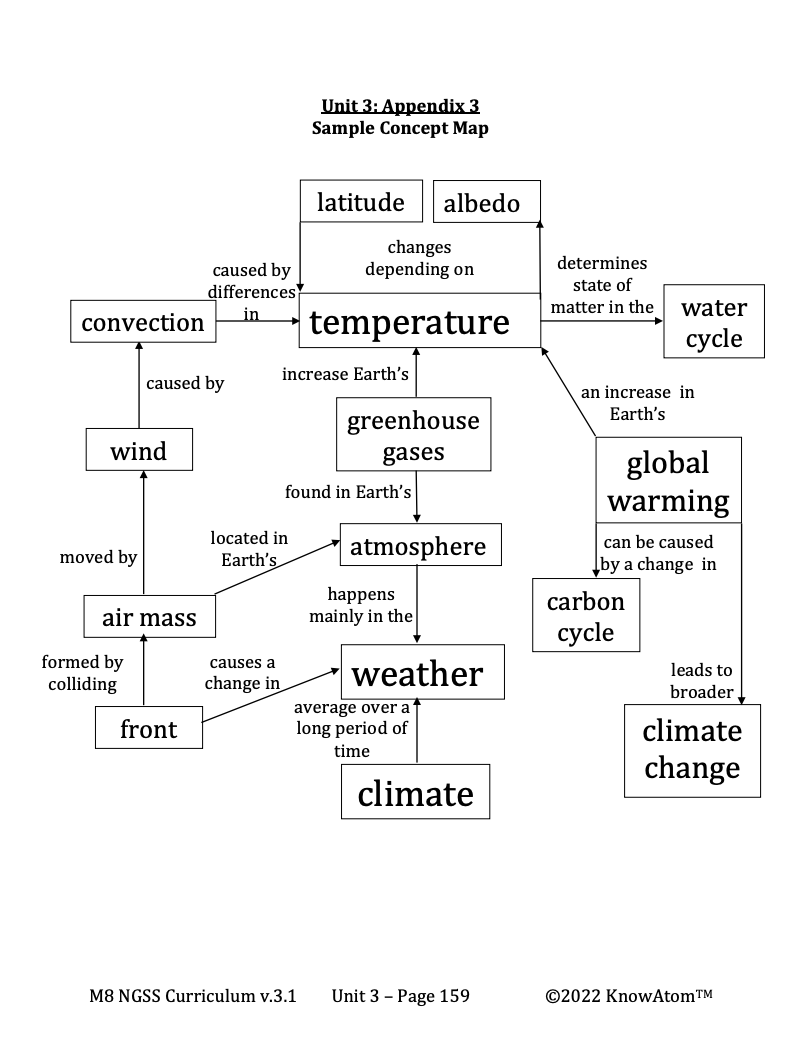Students use their scientific knowledge about Earth’s climate and the greenhouse effect to figure out how to engineer greenhouses, using various methods to achieve the desired internal temperature range.
In this unit, students evaluate how Earth is heated unevenly by investigating how the angle that the sun’s rays hit Earth affects temperatures at different locations. In this lesson, students use their scientific knowledge of phenomena related to global warming and climate to engineer a model greenhouse that reaches a specific temperature. This pages provides a snapshot of this lesson.
The science background section provides teachers with in-depth information about the phenomena students explore in this unit on climate. Below is an excerpt of the science background section on engineering greenhouses.
Climate change is a central focus of scientists around the world because of the wide-ranging impacts a changing climate will have on regions all over the planet.
The Intergovernmental Panel on Climate Change (IPCC) is a group of scientists from around the world who assess current understanding and the potential impacts of climate change. The IPCC reports that the world’s surface air temperature has increased by an average of 0.6 degrees Celsius (1 degree Fahrenheit) during the 20th century. Furthermore, the group predicts that temperatures are likely to increase even more during the 21st century. These findings are significant because even a 1-degree change can cause changes around the world.
The following are some changes that are expected with the rising temperatures:
Now that climate scientists have identified the problem of climate change and understand possible causes, some engineers are trying to come up with solutions to slow Earth’s warming. One problem that some engineers tackle is how to grow different kinds of plants year-round.
Their solution is often a greenhouse—a structure that is similar to how Earth is warmed. The design plays an important role in how well the structure is able to regulate the temperatures inside. Radiant heat from the sun enters the greenhouse through its transparent covering of glass or plastic and starts to warm the objects, soil, and plants inside. The heated surface warms the air above it, and through convection, heats the rest of the greenhouse. Because the greenhouse is tightly sealed, all of the air remains relatively warm. If even a small window is opened, the temperature will become cooler.
The world’s largest greenhouse is located in Great Britain, and houses thousands of plant species from all over the world. Called the Eden Project, it is home to two massive greenhouses consisting of adjoining domes. The first dome mimics the climate of tropical rainforests, while the second dome mimics the climate of Mediterranean farms.
The first designs of the Eden Project biomes were drawn on a napkin over a drink in a pub. Over time, the design evolved to mimic giant bubbles because of bubbles’ ability to settle anywhere, even on uneven surfaces. The engineers also wanted to use the fewest possible materials when building the domes. They decided to look to nature for inspiration, and the engineering skills of bees. They designed the domes of the Eden Project using hexagonal shapes, just like honeycombs, which provide for a strong structure with minimal materials. The different biomes are designed to keep the inside air temperatures within a very specific range. Engineers used a variety of methods to achieve this. For example, the domes are made of a double-layered insulating material that traps air in between the two layers, acting as a thermal blanket.
Students use their scientific knowledge about Earth’s climate and the greenhouse effect to figure out how to engineer greenhouses, using various methods to achieve the desired internal temperature range.

Prepared hands-on materials, full year grade-specific curriculum, and personalized live professional development designed to support mastery of current state science standards.
Misconception: Global warming and the greenhouse effect are the same.
Fact: The greenhouse effect is essential for life on Earth because it keeps the planet at a habitable temperature. Most scientists believe that the current global warming is caused by a dramatic increase in the number of greenhouse gasses in the atmosphere, which upsets the natural balance of the carbon cycle.
Carbon cycle : the circulation and transformation of carbon back and forth between living things and the environment
Climate change : a significant change in the average weather in a location over 30 years or more, including changes in temperature, precipitation, or wind patterns
Greenhouse gas : molecules in the atmosphere that absorb thermal energy from the sun and warm Earth’s surface and atmosphere; include carbon dioxide, water vapor, and methane

Studying Climate Change
There are many questions that remain unanswered about how Earth is changing and what the impacts of warmer temperatures will be. Global warming leads to other changes, such as stronger hurricanes, melting glaciers, and the loss of wildlife habitats.
These changes are called climate change, and they happen because Earth's air, water, and land are all related to one another and to the climate. A change in one place can lead to changes in other places. For example, as Earth gets warmer, more water evaporates from the surface, becoming water vapor, a greenhouse gas. More water vapor in the atmosphere leads to even more warming, which will lead to more evaporation, which will lead to more warming.
Scientists are still trying to understand how this feedback loop impacts global warming. Many scientists around the world are studying different aspects of climate change to try to better understand how all of Earth’s systems work together. One example of this is the researchers focusing on how warmer temperatures affect the latitude in which plants such as sugar maples are found. This is because many climate scientists are worried that climate change will significantly alter weather systems around the planet. This could make life more difficult for living things, which will have to adapt to the rapid changes or risk becoming extinct.
Designing a Greenhouse
Engineers have already designed technologies that apply scientific knowledge about heat transfer and Earth’s climate. For example, step inside a greenhouse, and one of the first things you’re likely to notice is that the temperature inside is much warmer than the temperature outside. Even on wintery days, greenhouses are usually filled with a variety of plants, including different kinds of flowers and vegetables. Behind the scenes, engineers have worked to make sure that the temperature can be maintained. If the weather outside changes dramatically, plant growers operating the greenhouse can monitor and change the amount of heat, light, and water their plants are getting.
The design of a greenhouse plays an important role in how well it is able to regulate the temperatures inside. Radiant heat from the sun enters the greenhouse through its transparent covering of glass or plastic and starts to warm the objects, soil, and plants inside. The heated surface warms the air above it. As the air heats up, it begins to rise, and through convection, cooler air fills its space. That cooler air becomes heated as well. Because the greenhouse is tightly sealed, all of the air inside remains relatively warm. If even a small window is opened, the temperature will drop. Greenhouses can also become humid because of plant transpiration, which releases water vapor into the atmosphere.


Some greenhouse owners experiment with inexpensive ways to increase heat, such as painting containers black to absorb heat and filling them with water to keep the heat. Most engineers also use location, positioning the greenhouse where it will get the most direct sunlight.
When an engineer designs a greenhouse, they research the specific needs of that particular greenhouse. For example, what kinds of plants will be grown, and what is their ideal temperature range? How many plants will be grown, and how much space do they need to grow? What is the climate of the location like, and how much sun does that location usually get? How much do the various materials cost?
In this engineering lesson, students design and build a greenhouse prototype to maximize the amount of thermal energy transferred to the structure from a heat source. Students analyze temperature data they collect during the prototype tests and calculate the total cost of materials used for each prototype. They use the data to evaluate the effectiveness of their greenhouse prototypes in meeting the minimum internal temperature requirements at a low cost.
KnowAtom incorporates formative and summative assessments designed to make students thinking visible for deeper student-centered learning.

Standards citation: NGSS Lead States. 2013. Next Generation Science Standards: For States, By States. Washington, DC: The National Academies Press. Neither WestEd nor the lead states and partners that developed the Next Generation Science Standards were involved in the production of this product, and do not endorse it.
